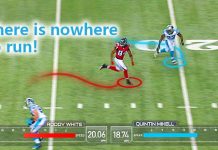RFID technology is more economical and practical than other technologies. RFID in retail can bring many benefits and opportunities to offline brick-and-mortar and online stores. But that doesn’t mean anyone is a good candidate for RFID, and to ensure you get the most out of your investment, you need to know a little about it. This paper will outline the benefits of RFID in retail stores and explain the reasons why retailers should choose this technology.
The Historical Beginnings of RFID in Retail
RFID has attracted the attention of American retail giant Wal-Mart as early as the early 2000s. At the time, Wal-Mart invested nearly $500 million in the RFID Association. It means that they are very optimistic about RFID technology. In 2001, British retailer Marks and Spencer implemented RFID tools. Today, RFID technology is still one of their core technologies. They also participated in a research project for this purpose. The project results showed a 5.5% increase in sales using RFID tracking. Inventory levels of lost and stolen inventory and employee costs have all been reduced due to RFID use.
Why do Retailers Choose to Use RFID?
RFID can give retailers better visibility into the entire sales process. Including the supply chain from manufacturing to distribution. RFID in supply chains can give managers real-time visibility of their product locations. Whether those products are stored on pallets, in containers, or on their way to stores. It can provide companies with information about inventory locations and other availability.
Using RFID in retail can also streamline the workflow of employees. Employees can get more done in less time using RFID tags. Employees can scan hundreds of assets at a time. Bar codes are the opposite of RFID. A bar code can only scan one item at a time and has to look directly at the bar code. Employees will spend more time working with barcodes than with RFID.
Another factor in choosing RFID for retail use is that it improves inventory accuracy. It is evident in a case report involving ten industry leaders. Introducing an RFID asset tracking system has improved the inventory accuracy of retailers. They improved from 66-77% to 93-99%.
River Island, a retailer specializing in apparel, has also implemented an RFID system. Since implementing the system, its inventory accuracy has increased from 70% to 98%. River Island has seen an increase in sales from the RFID asset tracking system. The retailer can also ensure that its most popular product lines are always in stock. Consumers can buy the products they want.
Inventory management is critical for any retail store. According to the study, 80% of consumers say they need to see real-time inventory on a retailer’s website. If the site cannot see the real-time inventory of the merchandise, they are less likely to patronize it. RFID asset tracking systems can help retailers solve this trouble. It automatically tracks the entire process, from the arrival of inventory to the sale of merchandise. It also ensures that the inventory count is updated instantly on the website/system backend. Guests/employees in offline stores and online shopping can know the store’s inventory information.
RFID vs. Barcodes: Understanding the Differences
While barcode technology is more common in retail settings than RFID, the two technologies have distinct differences. Bar codes serve as price tags and inventory tracking tools, storing basic information such as price and origin. They can be easily generated and shared through email or mobile phones for printing or scanning.
Here’s a table comparing RFID and barcodes:
| RFID | Barcodes | |
|---|---|---|
| Definition | A technology that uses radio waves to read and capture information from a tag attached to an object | A series of vertical bars and spaces that represent data, printed on a label or tag |
| Line-of-sight | Not required | Required |
| Read range | Several feet | Close proximity |
| Data storage | More information can be stored | Limited information can be stored |
| Durability | More resistant to harsh conditions | Limited resistance to harsh conditions |
| Efficiency | Can scan multiple items simultaneously | Must scan each item individually |
| Security | Can be encrypted for added security | Limited security features |
| Cost | Higher cost per tag | Lower cost per label or tag |
| Application | Inventory management, supply chain, logistics, retail | Inventory management, retail, point-of-sale |
| Limitations | Interference from metal or liquids | Must be in good condition to be scanned |
In contrast, RFID tags are embedded in objects and don’t require line-of-sight to a reader. They can complement bar codes by holding more information and having a larger read range.
There are several advantages to using RFID over bar code scanning in retail:
- Increased efficiency: RFID can scan multiple items simultaneously, saving time and increasing productivity.
- Improved durability: RFID tags are more resistant to harsh weather conditions such as sun and rain, making them ideal for outdoor use.
- Enhanced security: RFID tags can be encrypted to ensure that only authorized readers can access the data, providing an extra layer of protection.
RFID vs. NFC: Understanding the Differences
Near-field communication (NFC) is a type of RFID technology allowing two-way communication between devices. Unlike traditional RFID, both ends of an NFC connection can send and receive data.
Here’s a table comparing RFID and NFC:
| RFID | NFC | |
|---|---|---|
| Definition | A technology that uses radio waves to read and capture information from a tag attached to an object | A subset of RFID technology that allows for two-way communication between devices |
| Line-of-sight | Not required | Not required |
| Read range | Several feet | Within a few inches |
| Data storage | More information can be stored | Limited information can be stored |
| Durability | More resistant to harsh conditions | Limited resistance to harsh conditions |
| Efficiency | Can scan multiple items simultaneously | Can send and receive data |
| Security | Can be encrypted for added security | Can be used for contactless payment methods |
| Cost | Higher cost per tag | Lower cost per tag |
| Application | Inventory management, supply chain, logistics, retail | Contactless payments, access control, data transfer |
| Limitations | Interference from metal or liquids | Short-range communication only |
NFC is typically used for short-range communication, with both devices needing to be within a few inches of each other. In retail, NFC is commonly used for contactless payment methods, such as when a customer pays using a smartphone or other digital wallet.
While both RFID and NFC have similarities, such as the ability to store and transmit data wirelessly, they have distinct differences. RFID is primarily used for one-way communication, with the scanner receiving or sending data, while NFC allows for two-way communication between devices.
RFID in Retail Supply Chain
RFID technology uses electromagnetic fields to identify and track tags attached to objects automatically. In the retail industry, RFID technology is used in the supply chain to track the movement of products from the manufacturer to the store shelves.
RFID can improve the efficiency of the retail supply chain by automating and streamlining processes. RFID tags can be attached to individual products or cases, allowing retailers to track inventory in real-time, reducing the time it takes to conduct inventory checks, and minimizing out-of-stock situations.
Research has shown that RFID can increase inventory accuracy to nearly 100%, reducing the need for safety stock and lowering inventory carrying costs. RFID can also improve supply chain visibility, allowing retailers to track products at every supply chain step, from production to delivery.
Furthermore, RFID technology can help retailers manage their promotions more effectively. By tracking the movement of products in real-time, retailers can determine which products are selling well and adjust their advertisements accordingly.
Another advantage of RFID technology is that it can enhance the customer experience. By improving inventory accuracy, retailers can reduce the likelihood of out-of-stock situations, leading to lost sales and dissatisfied customers.
Despite the benefits, the implementation of RFID technology in the retail industry has been slow due to the high costs associated with tagging products and upgrading existing infrastructure. However, as the technology becomes more widespread and costs continue to decrease, more retailers will likely adopt RFID to improve their supply chain efficiency and customer experience.
RFID technology can revolutionize the retail supply chain by improving inventory accuracy, enhancing supply chain visibility, improving promotion management, and ultimately providing a better customer experience.
Examples of RFID in Retail: RFID’s Success in Retail Apparel
Let’s use American Apparel as an example. Long before the company filed for bankruptcy, it operated 260 stores. Sales exceeded $600 million per year. The company deployed RFID in all 260 of its stores simultaneously. And because of off-sales and labor reductions, RFID made the company more money.
RFID has delivered a higher return on investment for American Apparel than stores using other technologies. The company has increased revenue by 14 percent at each of its stores. The store saves nearly 190 hours of labor per month. It represents a significant reduction in American Apparel’s labor costs per store.
RFID automates the process by increasing inventory visibility. It enables each store to provide customers with a complete supply of products. With adequate supply, store revenue naturally increases. It also helps employees spend less time on weekly cycle counts and inventory searches. Employees can have more time to serve every customer who comes to the store.
However, it is not just technology that determines a company’s survival. However, RFID has brought many benefits to the company. But about why the company went bankrupt, you may need to check other information yourself.
Benefits of RFID in Retail
RFID is a great presence for retailers and consumers alike. RFID allows retailers to automate their inventory data and increase accuracy by 30%. It also helps reduce their out-of-stock situations. RFID in retail stores allows for smarter service for customers who come into the store. A customer enters the store, looks at an outfit, and enters the fitting room. The smart mirror then matches the customer with the perfect outfit. Then the customer can hand-carry the goods quickly self-checkout. It is very tempting for some people who have difficulty choosing clothes, and the smart mirror is very tempting. Here are some more examples and benefits of RFID in retail.
RFID Streamlines Inventory Processes
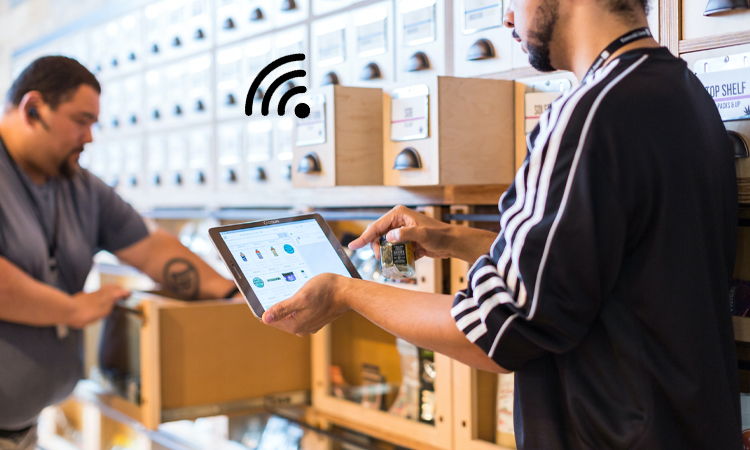
Retailers can use RFID to streamline and improve the accuracy of their store inventory processes. The traditional way of recording retail inventory is time-consuming and manual. With RFID, you can accurately and quickly register all your goods. You won’t need to scan individual packages and look at receipts to confirm the status of your shipments. You can easily use it to locate individual items. It helps reduce cycle inventory time. It also automatically orders products within safety stock levels, so you don’t have to worry about running out of stock.
RFID Improves Retail Store Operations
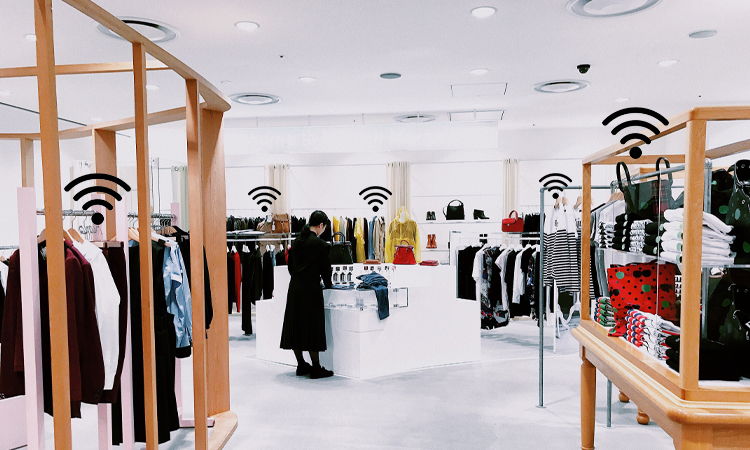
As you know, the apparel industry is a complicated business. The styles, lengths, and patterns of the clothes you sell can vary. Using traditional methods to track your inventory can be a headache. Because you can easily write wrong. You also need help keeping enough inventory for each variation. Some items may be out of stock. Your customers will not be able to buy the clothes they want when they come to the store. Your customers can easily be taken away by their peers. I’m sure you don’t want that to happen.
RFID helps to improve your store’s inventory management. RFID notifies store personnel when specific items are running low. RFID also makes it easy for store associates to know how many items are in stock.
RFID Analyzes In-Store Customer Traffic

The vast majority of retailers use RFID to track the movement of merchandise throughout their stores. You can use this information to determine the high-traffic end of the store, the pinch points. You can also gain a deeper understanding of your employees from the information you collect. Find out how well your employees are selling and which items are selling better. You’ll be able to develop better store operations plans for this.
RFID Makes Fitting Rooms Smarter
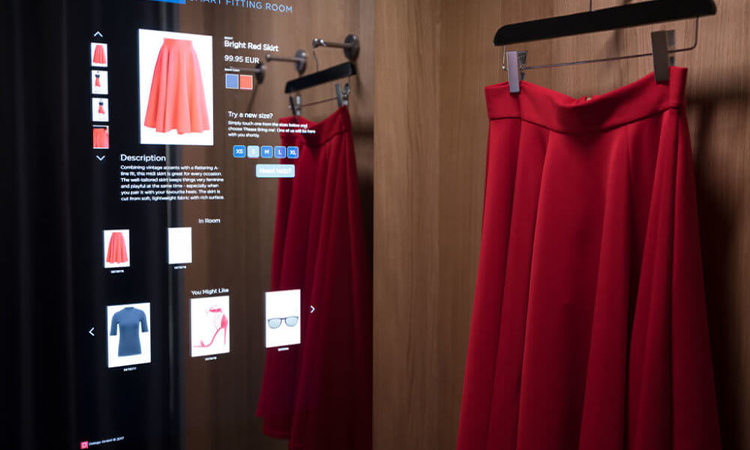
RFID-chipped “magic mirrors” or touch-screen displays can be used as fitting room mirrors. This mirror has more functions than ordinary mirrors. It tracks items by geolocating RFID tags on clothing. The smart mirror will also make recommendations for guests to help them find the perfect match. Once the guest has changed, they can easily find other available colors for that outfit by looking in the mirror. The smart mirror will also suggest other matching outfits for your customers. It means that your store has a high probability of generating more revenue.
You can also more easily recruit and train store associates. Because they only need to do some reception and checkout work most of the time. Employees can make door-to-door customers a more satisfying shopping experience.
RFID in Retail Stores Makes Checkout Faster
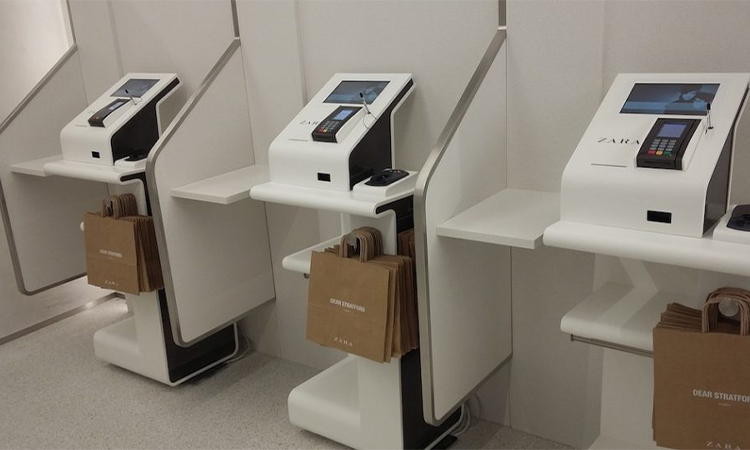
Contactless payments using RFID enable people to check out faster and more securely. Contactless payments typically refer to transactions completed with a cell phone, debit or credit card, or key. Retail stores use POS systems for contactless payments to help simplify the checkout process for customers.
Customers can self-checkout after selecting items instead of waiting in line to checkout manually. Customers can scan RFID-tagged items through a self-checkout machine. Once the items are scanned, they can check out via RFID and verify their identity using a biometric scanner. The customer can leave the store after successful payment. It shortens the time customers wait for checkout and reduces employees’ workload. Customers feel a sense of comfortable shopping experience in your store. The number of repeat customers will naturally increase later.
Good customer service is essential for any industry, especially retail. According to InMoment research, good customer service can greatly increase customer satisfaction. Positive interactions between employees and customers can enhance their favorability towards the store. Good service and positive interactions are key to the entire retail industry. It increases customer satisfaction by 33%. In fashion retail, this can increase to 70%, which is an impressive figure. The use of RFID in retail gives employees more time to provide better service to customers. Customers come back satisfied, so won’t there be more repeat customers?
Most people consider RFID as the technology of choice to further develop the new era of retail. There are many other asset-tracking solutions on the market, such as barcodes, NFC, and Bluetooth. However, the use of RFID in retail has proven to have a positive impact on all brick-and-mortar stores. Businesses using RFID can increase control over inventory and also reduce labor costs. It also opens the door to a new world of other innovative uses. Of course, RFID can be used not only in retail. You can also use it in various industries, such as healthcare and food.
General Questions About RFID in Retail
-
What is RFID technology, and how is it used in retail?
RFID stands for Radio Frequency Identification, a technology that uses radio waves to read and capture information from a tag attached to an object. In the retail industry, RFID technology can track inventory, prevent theft, and improve the shopping experience.
-
How does RFID technology help retailers reduce theft and prevent losses?
RFID can be used to track products and prevent shoplifting and other forms of theft. It can also be used to track returned products and prevent fraudulent returns.
-
What is the cost of implementing RFID technology in retail, and is it worth the investment?
The cost of implementation can vary depending on the size of the store and the scale of the project. However, RFID technology can significantly benefit inventory management, sales, and customer experience.
-
How can RFID improve supply chain visibility and efficiency in the retail sector?
RFID can enable real-time tracking of products and shipments, reduce supply chain inefficiencies, and improve logistics and transportation management.
-
What are the regulatory requirements and standards for using RFID in retail stores?
Regulatory requirements and standards vary by region and industry. Some common standards include ISO 18000-63 and GS1 EPCglobal.
-
What are the environmental impacts of using RFID technology in the retail industry?
RFID can reduce waste and improve sustainability by enabling more accurate inventory management, reducing overstocks and stockouts, and optimizing transportation and logistics.



